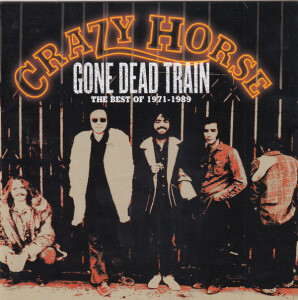 The first time Crazy Horse’s name appeared on a record was on Everybody Knows This Is Nowhere billed as Neil Young and Crazy Horse. The record was a dramatic change for Neil Young from his heavily produced solo album. This saw him fronting a real rock band. A garage band, raw and powerful. When they released their first album under the new monicker (they had been called The Rockets for a time) it was under the watchful eye of legendary producer Jack Nitzsche who joined on piano and it was a cracker! Released in 1971, Crazy Horse was one of those amazing first albums that didn’t have a bad track. Sure, Neil was on board for a track or two, studio wiz Ry Cooder added some bottleneck guitar and Nils Lofgren helped out too, but this was Crazy Horse’s show all the way.
The first time Crazy Horse’s name appeared on a record was on Everybody Knows This Is Nowhere billed as Neil Young and Crazy Horse. The record was a dramatic change for Neil Young from his heavily produced solo album. This saw him fronting a real rock band. A garage band, raw and powerful. When they released their first album under the new monicker (they had been called The Rockets for a time) it was under the watchful eye of legendary producer Jack Nitzsche who joined on piano and it was a cracker! Released in 1971, Crazy Horse was one of those amazing first albums that didn’t have a bad track. Sure, Neil was on board for a track or two, studio wiz Ry Cooder added some bottleneck guitar and Nils Lofgren helped out too, but this was Crazy Horse’s show all the way.
Five tracks from that first album lead off Raven’s new anthology. And they are arguably the best cuts you could ask for. Nitzsche’s and Titelman’s “Gone Dead Train” is the first song and it rocks out like crazy. First heard on the Performance soundtrack, sung by Randy Newman, this song simply sums up what rock’n’roll is all about! One listen and you’ll understand why critic Robert Christgau called Crazy Horse “the greatest hard-rockin’ band in America except for the Ramones!” They continue in this vein with the country rock of Neil Young’s “Dance, Dance, Dance,” the smoldering “Beggar’s Day” and Danny Whitten’s (written with Neil Young) “Downtown.” Whitten, who was Crazy Horse’s singer and guitarist, also contributed the lovely ballad “I Don’t Want To Talk About It.”
After this introduction, the discerning listener is willing to listen to whatever is on offer. And the good news is, they don’t let up. This collection rocks out for almost 80 minutes! Their second album was called Loose and it was, so the compilers have ignored it completely, and moved on to 1973’s At Crooked Lake for a handful of tunes. Billy Talbot (bass) and Ralph Molina (drums) were the mainstays of the group, with Whitten as the frontman. But when he died of a drug overdose, they continued with a revolving door policy of new singers and guitarists. Whatever they did seems to have worked. With the addition of Rick Curtis and Michael Curtis on guitar and keyboards, the third album was quite a bit stronger. More like the first album, it contained strong tracks like “Rock and Roll Band” and “Don’t Keep Me Burning.” These are two of the four tracks included here.
Molina and Talbot maintained the Young connection for a while but it would be four years before another label would release a Crazy Horse album. Crazy Moon came out in 1977. Guitarist Frank “Pancho” Sampedro had been added to replace the Curtises. “Pancho” fit into the mix very well. Crazy Moon was a solid album and it is repesented by five tracks on this collection. One notable difference is, the songs are written by Molina, Talbot and Sampedro — they were becoming self-reliant in their songwriting — and Neil Young was back to add some stinging guitar solos. Whew! These tracks are hot.
The album continues with a selection of tracks from 1989’s Left For Dead album. Ralph and Billy provide the rhythm section with new members Matt Piucci (guitar) and Sonny Mone (vocals/guitar) filling Neil’s shoes. They crank up the volume on the guitars and do their best Young impression on Mone’s songs “Child of War” and “World of Love.”
Gone Dead Train closes with two songs from 1968. The Rockets. Back to where they began. Danny Whitten’s “Let Me Go” takes us out. It’s amazing that so many personnel changes, so much tragedy, could lead to so many great (but virtually unknown) songs. These guys deserve to be heard. The album flat out rocks.
(Raven, 2005)
